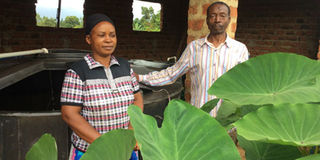Couple strike gold in aquaponics

The Mulamatas earn from selling fingerlings (Below). They also sell mature fish. Photo s by joan salmon
What you need to know:
- At their aquaculture farm in Buddo, Joyce and Charles Mulamata rear two species: the African catfish and tilapia, writes Joan Salmon.
Despite having several other businesses that were taking them places; metal fabrication workshop for making steel doors and windows, and a solar installation company, Joyce and Charles Mulamata had a deeply ingrained passion for fish farming.
It is this which got them investing all their savings into pond fish farming.
“We dug our ponds at Kigo,” Mulamata shares, “But that would later lead to our downfall, seeing that we stayed in Rubaga.” The Mulamatas went to check on their farms every alternating weekend. However, on one of the weekends, they found the workers and the fish gone. That was between 2003 and 2005.
Looking back, Mulamata says, “Apart from lack of close and constant supervision, we lacked knowledge about fish farming, coupled with poor management, lack of security and trusting people that we thought knew the trade yet they did not. All this led to total losses.”
Getting back up
With the fish farms totally gone, the Mulamatas had to survive, so it was only wise to continue what they were doing before as well as look for more money making ventures.
“I travelled a lot for business—related issues; Germany to support the solar company, Turkey for metal fabrication machinery as well as to USA, UK, Austria and Germany to sell bamboo bicycle frames,” says Mulamata.
It was during one of these travels that he saw aquaponics in USA, and UK, however, it was on large scale.
Their next challenge was to scale down what he had seen to something they could manage.
Starting
Getting back home, they started looking through their store for pumps, pipes and also made use of an old refrigerator that was not only big enough but also had an enamel strong enough to hold huge amounts of water securely. That was around 2010.
That was the genesis of the aquaponics project whose roots was in Rubaga. Alongside the fish, they planted strawberries, maize, yams, sukuma wiki, beans, cucumber, cabbage, and tomatoes which did exceptionally well.
As for anything good and awe inspiring, word went around town about the extraordinary fish farming technique.
“We started to have study tours from various interested parties,” explains Mulamata, “It was during one of these study tours that we hosted dignitaries such as Ruth Nankabirwa and Joyce Ssebugwawo, who inaugurated the Aquaponics Association.”
To add to the joy of perseverance, they won entrepreneurship awards in two consecutive years; 2012 and 2013 from Citibank, received a journalist from the US; Jonathan Miller on a mission to interview them. With him, he carried what they came to call the best gift ever; an authority book from Pro Michael Ben Timmons from the University of Cornell — Recirculation Aquaponics Systems 2nd Edition.
Expansion
“After experimenting, it was time to go commercial,” Mulamata says, “And we could not expand in the small space at Rubaga thus moving to Buddo. However, we are still scaling up in Namabo, Mpigi where we have 11 acres of land.”
The fruits were still coming as they would later be awarded a grant —Skills Development Fund of the World Bank under Private Sector Foundation to train 40 Ugandans in tank fish farming using commercial aquaponics.
“We have so far trained 23 people and 10 have already adopted the systems—they are at various stages of implementation,” says Mulamata.
Setting up the system
“There is no space too small for this system,” Mulamata says, breaking all preconceived notions I had. “To have it installed, one pays for membership, and goes through the training,” he says.
Not every fish will thrive in this system, I get to learn, “Nile tilapia and African cat fish are the best fish for aquaponics. They are warm water fish and anything below 50 degrees Fahrenheit would kill them,” Mulamata points out.
With this information, it is undoubtedly true that aquaponics is viable in Uganda owing to the plenty of sunshine.
Making the most of Aquaponics
“Fish farming fails due to poor seed, costly feeds and poor management,” the farmer reveals.
Every farmer longs to make profits from their farming activity and one way to achieve that is looking at stocking density.
“In a fish pond of 1m×1m×1m, taking in 1,000 litres of water, you can stock one to two kilogrammes of fish. However, in a tank of similar dimensions, you can stock 20-60 kilogrammes of fish,” he says. That gives you hope of bigger harvests.
Feeding
Another important issue to look at is feeds as these constitute 60 to 70 per cent of the costs on the farm thus the need to economise. Currently, feeds (pellets) cost between Shs3,500 for local feeds and Shs10,900 for feeds from Israel.
Compared to other animals, fish take up the least amount of feeds to give you one kilogramme of produce; cat fish consumes 1.8 kilogrammes while tilapia consumes 1.5 kilogrammes. With tanks being more manageable, you are less likely to waste feeds compared to when your fish are in a pond.
Maintenance
It is very essential for fish survival that the water is clean lest the fish die due to stress.
Aquaponics greatly helps with that. Mulamata explains that the cleaning is done in two phases; the point where the fish droppings are collected and the beds that act like swamp vegetation, taking in the urine, food remains plus residue droppings.
Quicker yields
In the African model, fish will take nine months to mature, no wonder people opt for broiler rearing for quicker turn over. However, with Aquaponics, Mulamata says they adopt the Asian model. “Our fish is ready for marketing after six month,” he says.




